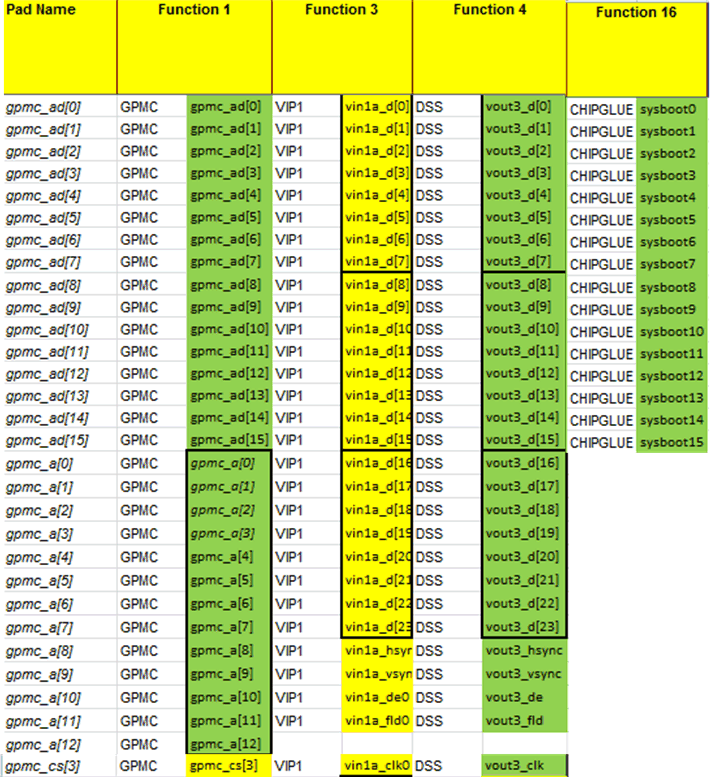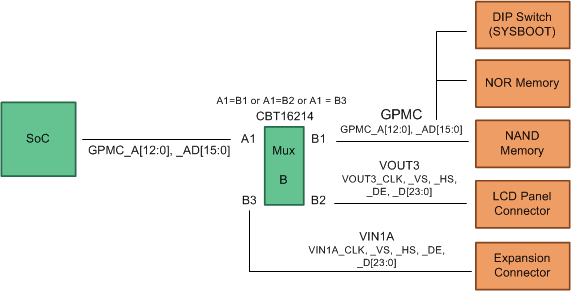SPRUIF3B May 2017 – March 2019 DRA790 , DRA791 , DRA793 , DRA797
-
DRA79x EVM CPU board
- Trademarks
- 1 Introduction
- 2 Overview
- 3
Hardware
- 3.1 Hardware Architecture
- 3.2 DRA71x, DRA79x, TDA2E-17, and AM570x Processor
- 3.3 Power Architecture
- 3.4 Reset Structure
- 3.5 Clocks
- 3.6
Memory
- 3.6.1 SDRAM Memory
- 3.6.2 QSPI Flash Memory
- 3.6.3 EMMC Flash Memory
- 3.6.4 MicroSD Card Cage
- 3.6.5 GPMC NOR Flash Memory
- 3.6.6 GPMC NAND Flash Memory
- 3.6.7 Boot Modes
- 3.6.8 JTAG/Emulator and Trace
- 3.6.9 UART Terminal
- 3.6.10 DCAN and CAN Interfaces
- 3.6.11 Universal Serial Bus (USB)
- 3.6.12 Wired Ethernet
- 3.6.13 Video Output
- 3.6.14 Video Input
- 3.6.15 Mini-PCIe
- 3.6.16 Media Local Bus (MLB)
- 3.6.17 Audio
- 3.6.18 COM8 Module Interface
- 3.6.19 eFuse Programming Supply
- 3.6.20 User Interface LEDs
- 3.6.21 Power Monitoring
- 3.6.22 I2C Peripheral Map
- 3.6.23 GPIO List
- 3.6.24 I/O Expander List
- 3.6.25 Configuration EEPROM
- 4
Signal Multiplex Logic
- 4.1 GPMC and QSPI Selection (MUX A)
- 4.2 GPMC, VIN1, and VOUT3 Selection (MUX B)
- 4.3 GPMC and EMMC Selection (MUX C)
- 4.4 VIN2A and EMU Selection (MUX D, MUX E)
- 4.5 VIN2A and RGMII1 Selection (MUX F)
- 4.6 RGMII0 and VIN1B Selection (MUX J)
- 4.7 SPI2 and UART3 Selection (MUX K)
- 4.8 DCAN2 and I2C3 Selection (MUX L)
- 5 USB3 Supported Configurations
- 6 References
- Revision History
4.2 GPMC, VIN1, and VOUT3 Selection (MUX B)
Figure 10 is part of the SoC pinmux table for GPMC. The SoC device supports additional functions not shown in the table. The functions shown are intended to reflect those supported on the EVM. These functions include:
- Memory Bus (GPMC): AD[15:0], A[12:0]
- Video Input Port (VIN1A): CLK, HSYNC, VSYNC, DE, and D[23:0]
- Video Output Port (VOUT3): CLK, HSYNC, VSYNC, DE, and D[23:0]
- Boot Mode Selection (SYSBOOT): SYSBOOT[15:0]
 Figure 10. SoC Pinmux for GPMC, VIN1, and VOUT3
Figure 10. SoC Pinmux for GPMC, VIN1, and VOUT3 MUX B: Selects between NOR and NAND memories, LCD panel for video, and expansion. The selection is made using the I/O expander 2, bits P7 and P0. The defaults is set to enable GPMC to NOR and NAND memories – which is required for SYSBOOT mode latching. Figure 11 shows the MUX diagram for GPMC, VIN1, and VOUT3
 Figure 11. MUX Diagram for GPMC, VIN1, and VOUT3
Figure 11. MUX Diagram for GPMC, VIN1, and VOUT3